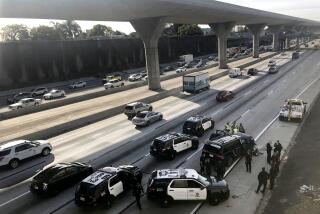TV Review : ‘Going’: Transportation, American Style
- Share via
The best place to watch PBS’ three-part series “Coming and Going” is on a monitor in a plane, or a train, or even in an automobile. This sometimes serious, sometimes off-kilter exploration of American transportation passions and problems is as much in motion as its subject. Being sedentary, in your living room, is not the place to be for this show.
Producer Craig Perry assembles the series’ various pieces with intelligence, if not always with care. It’s the mark of a different TV program on transport issues when you hear from peripatetic musicians Willie Nelson and Kris Kristofferson or novelist Robert Stone. A compelling cast on paper, but the talking heads do not always have something worth hearing.
“Coming and Going,” unlike much of the U.S. interstate highway system, refuses to move in a straight line. Except in the final and most important hour, “Road to the Future,” the first two segments zig and zag like a plane in a turbulent air flow.
“Over the Long Haul,” a sometimes loving depiction of the human and cybernetic aspects of freight transport, and “Coast to Coast,” which reflects on travel by train, car and plane, flash back and forth across history via archival and new footage. Sometimes, only narrator Scott Simon’s quietly assertive voice keeps matters together.
Along this video road, countless fascinating facts whiz past us like so many funky Route 66 signs. The internationally standardized container, created in the 1960s, has revolutionized commercial freighting. Once, longshoremen had to worry about tarantulas creeping out of shipped fruit; now, the fruit is in containers. Later, we learn that Chicago happened by an accidental coming together of land routes and then became a kind of land port. Portland, we learn, has solved its public transit problems by killing freeway projects and bulldozing parking lots.
Perry attends to the personal experience of travel too, and does it best with Washington Post sports writer Mike Wilbon, who vividly describes the pressures, patterns and headaches of very frequent flying. (He also tells us, that for this black kid growing up on Chicago’s South Side, travel was the best education of all.)
Much of the first two hours, though, is familiar stuff--the American romance with the road (Brando in “The Wild One”: “You just . . . go!”), the national spirit of restlessness rooted in personal reinvention and improvement, the cowboy ethic of the wildcat trucker. In “Road to the Future,” however, we get down to the cutting issues that prominently concern Los Angeles.
Writer Joel Garreau convincingly explains why “edge cities” (our own Irvine and Warner Center are examples), built at the metropolitan fringe and for the car, are social dead-ends. Portland’s reinvention of a pedestrian-dominated downtown core is a humane alternative, while architect Andres Duany’s village-like developments are another. L.A.’s Metro Rail and commuter programs receive a few minutes here (along with jolly restaurant critic Merrill Schindler cruising down the Santa Monica Freeway).
Nothing, though, is said about telecommuting. Take it from this writer working at home: Nothing keeps the car off the freeway better than a computer modem.
* “Coming and Going” airs at 9 tonight on KCET-TV Channel 28 and continues June 17 and 24.
More to Read
The complete guide to home viewing
Get Screen Gab for everything about the TV shows and streaming movies everyone’s talking about.
You may occasionally receive promotional content from the Los Angeles Times.






